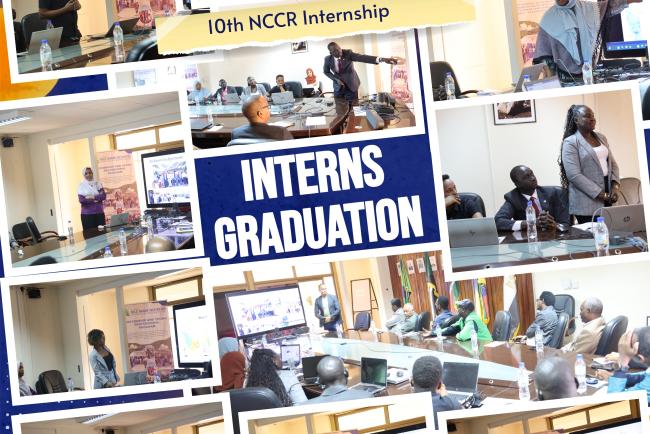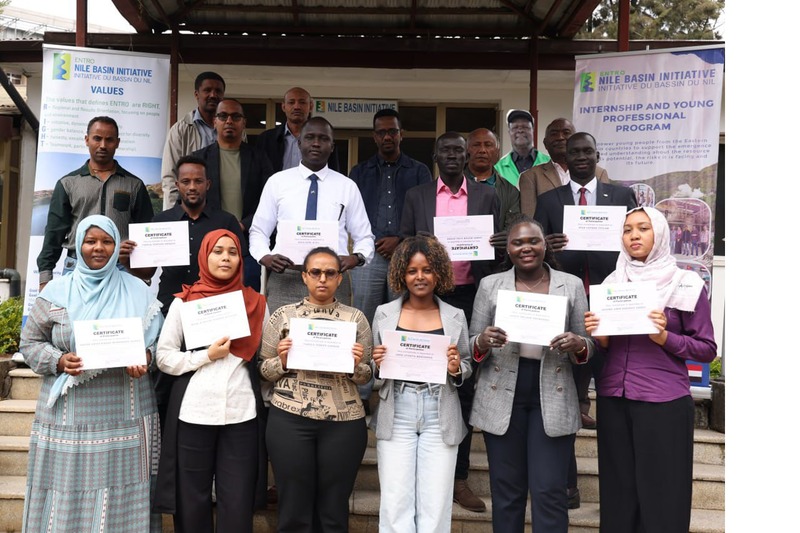10𝒕𝒉 𝑵𝑪𝑪𝑹 𝑰𝒏𝒕𝒆𝒓𝒏𝒔𝒉𝒊𝒑 𝑮𝒓𝒂𝒅𝒖𝒂𝒕𝒊𝒐𝒏 𝑪𝒆𝒓𝒆𝒎𝒐𝒏𝒚

The 10th NCCR Internship Batch has enrolled 10 Interns from the three Eastern Nile Countries (4 from South Sudan, 3 from Sudan, and 3 from Ethiopia) to the ENTRO Internship and Young Professional Program. These interns have been participating in training and capacity-building activities with the theme “Eastern Nile Drought Assessment” organized at ENTRO for the past three months, starting on November 1st to January 31st, 2025.
The main objective of the assessment is to quantify and monitor trends of categorical drought and its spatial and temporal distribution in the Eastern Nile Basin as well as update database at ENTRO for drought assessment. The 10th batch of NCCR interns were engaged in the "𝗘𝗮𝘀𝘁𝗲𝗿𝗻 𝗡𝗶𝗹𝗲 𝗗𝗿𝗼𝘂𝗴𝗵𝘁 𝗔𝘀𝘀𝗲𝘀𝘀𝗺𝗲𝗻𝘁" project divided into two themes:-
𝙏𝙝𝙚𝙢𝙚 𝙄: 𝙀𝙖𝙨𝙩𝙚𝙧𝙣 𝙉𝙞𝙡𝙚 𝙈𝙚𝙩𝙚𝙤𝙧𝙤𝙡𝙤𝙜𝙞𝙘𝙖𝙡 𝙖𝙣𝙙 𝙃𝙮𝙙𝙧𝙤𝙡𝙤𝙜𝙞𝙘𝙖𝙡 𝘿𝙧𝙤𝙪𝙜𝙝𝙩 𝘼𝙨𝙨𝙚𝙨𝙨𝙢𝙚𝙣𝙩
The assessment has been focused on hydrological and meteorological drought monitoring and trend analysis in the Eastern Nile sub basin, using the streamflow drought index (SDI), standardized precipitation index (SPI), respectively.
The Assessment has also looked into the interrelationships between the two drought indicators. The SDI and SPI were calculated using long-term streamflow and precipitation data collected from 1981 to 2021.
𝙏𝙝𝙚𝙢𝙚 𝙄𝙄: 𝘼𝙜𝙧𝙞𝙘𝙪𝙡𝙩𝙪𝙧𝙖𝙡 𝘿𝙧𝙤𝙪𝙜𝙝𝙩 𝘼𝙨𝙨𝙚𝙨𝙨𝙢𝙚𝙣𝙩 (𝙁𝙞𝙣𝙖𝙡 𝙧𝙚𝙥𝙤𝙧𝙩)
This study aims to monitor agricultural drought in the Eastern Nile Basin using satellite-based drought indices from MODIS dataset, given the region's data scarcity.
The research primarily utilized NDVI (Normalized Difference Vegetation Index), EVI (Enhanced Vegetation Index), and VCI (Vegetation Condition Index) to monitor agricultural drought. NDVI and EVI were used to analyze temporal drought trends, while an in-depth Spatio-temporal and frequency analysis were conducted using VCI for the four main sub-basins: Blue Nile, Main Nile, Baro-Akobo-Sobat, and Tekeze-Setit-Atbara.
After the Interns complete their work and delivering a presentation, the graduation ceremony was held in the presence of ENTRO technical staff.
